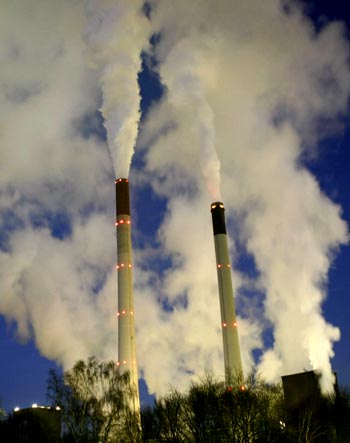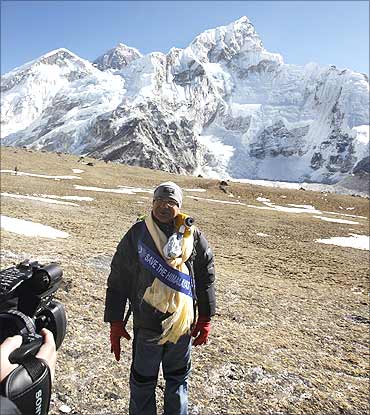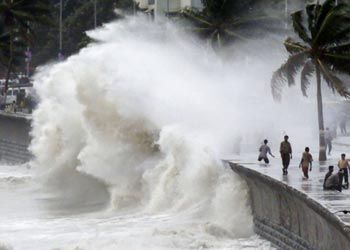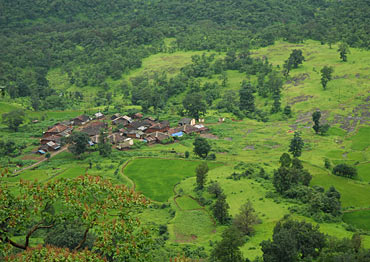Photographs: Reuters
India's key sectors like agriculture, water, forest and health will be affected in a major way due to the increase in net temperature by 1.7-2.2 degree Celsius in another 20 years in the four climate hotspots.
India's key sectors like agriculture, water, forest and health will be affected in a major way due to the increase in net temperature by 1.7-2.2 degree Celsius in another 20 years in the four climate hotspots.
The 'Climate Change and India: A 4x4 assessment' report, which was released on Tuesday providing an assessment of impact of climate change in 2030, also predicts an increase in precipitation (rain, snow and storm) in the eco-fragile areas of the Himalayas, North-East, Western Ghats and the coastal region.
Prepared by India's Network for Climate Change Assessment (INCCA), the report says: "The net increase in annual temperatures in 2030 with respect to 1970s would range between 1.7 degree Celsius and 2.2 degree Celsius with extreme temperatures increasing by 1 to 40 degree Celsius with maximum increase in coastal regions."
The maximum and minimum temperatures are also projected to increase in 2030s compared to 1970s while the extreme precipitation events are likely to increase by 5-10 days in all the four regions.
Similarly, as per report, all the regions are projected to experience an increase in precipitation in 2030s as against 1970s and the maximum increase will be in the Himalayan region, while minimum in the North East.
. . .
Scary! Droughts, extreme heat await India!
Photographs: Reuters
This is the second such report. The first Assessment of the Green House Gas emissions was released on May 11, 2010. It covered the sectors of energy, industry, agriculture, land use land use change and forest and waste by sources and removal by sinks presented in this document.
Climate change has emerged as a significant man made global environmental challenge and a threat. There are growing scientific evidence that there is a discernible impact of human activities on climate system.
There are several aspects of warming and climate change on which there is a wide agreement among the scientists. The scientific evidence of global warming is evident at the continental level whereas the understanding of the implications of climate change at the regional and sub regional level is rather inadequate.
Thus there is a need for more comprehensive studies and information at the regional and national level.
With changes in key climate variables such as temperature and humidity, sea level along the Indian coast has been rising at the rate of 1.3mm/year and is likely to do so in consonance with the global sea level rise in the future, the report says.
. . .
Scary! Droughts, extreme heat await India!
Photographs: Reuters
Further projections indicate that the frequency of cyclones is likely to decrease in 2030s, with increase in cyclonic intensity.
On agriculture front, the report says irrigated rice in all the regions are likely to gain in yields marginally due to warming as compared to the rain-fed crop as the irrigated rice tends to benefit from CO2 fertilization effect.
Speaking at a function after the report was released by Science and Technology Minister Kapil Sibal and economist M S Swaminathan, Environment Minister Jairam Ramesh said there was no country in the world that is as vulnerable to climate change as India.
"I am glad that for the first time such a comprehensive assessment has been undertaken," he added.
This is the second report from the INCCA which had in May released the country's greenhouse gas emission data for 2007, making India the first developed country to released update data on the emission.
. . .
Scary! Droughts, extreme heat await India!
Photographs: Reuters
The network launched last year has been visualised as a mechanism to evolve institutions as well as engage other agencies already working in the area of climate change.
The report also predicts that with overall warming, the thermal humidity index is projected to increases in all the regions, especially in May and June, leading to stress on the livestock and hence reduction in its milk productivity.
Similarly, water yield (which is a function of precipitation, total surface run-off, evapo-transpiration and soil properties), is projected to increase in Himalayan region in 2030s by 5-20 per cent. However, water yields are likely to be variable across the four identified climate sensitive regions.
Moderate to extreme drought severity is projected in 2030s for Himalayan region, as compared to the other regions.
However, all the regions are likely to experience flooding which are exceeding existing magnitudes by 10 per cent to 30 per cent, says the report.
. . .
Scary! Droughts, extreme heat await India!
Photographs: Reuters
On the health front, the report provides assessment on malaria which is projected to spread in new areas in Jammu and Kashmir in Himalayan region.
"In the North eastern region, opportunities for malaria transmission is likely to increase for a longer period. In the Western Ghats, no change is observed between in 2030s and the trends observed in 1970s," adds the report which has come ahead of the UN meet on climate change in Mexico from November 29.
In coastal region, "especially in the eastern coast, a marked decrease in the time period in which malaria transmission window would be open is projected," as per report.
China takes lead in combating climate change domestically: UN
Noting that as countries were pushing ahead with their national agendas to combat climate change more intensely than setting international obligations, China was leading in combating the problem domestically, UN climate chief Christiana Figueres has said.
Figueres pointed out that Beijing had "outperformed" the climate goal set in its 11th Fifth Year Plan and was already designing climate legislation for the 12th Plan to include clear targets for energy efficiency and renewable energy.
. . .
Scary! Droughts, extreme heat await India!
Photographs: Reuters
"There is no doubt the historic performance China has had on the 11th five year plan," Figueres told journalists during a press conference in Bonn, which was webcast live.
"They have not just performed to the level of their target but they have outperformed and it is well to think they will out perform again," she added.
Two weeks ahead of the annual meet on climate change, to be held in Cancun, Mexico, the UN climate chief observed that there is "optimism for the planet" since countries are taking climate change seriously at home.
Besides China, the top UN official referred to small countries like Maldives and Costa Rica that had taken a pledge of carbon neutrality and were designing national mitigation action plans.







article